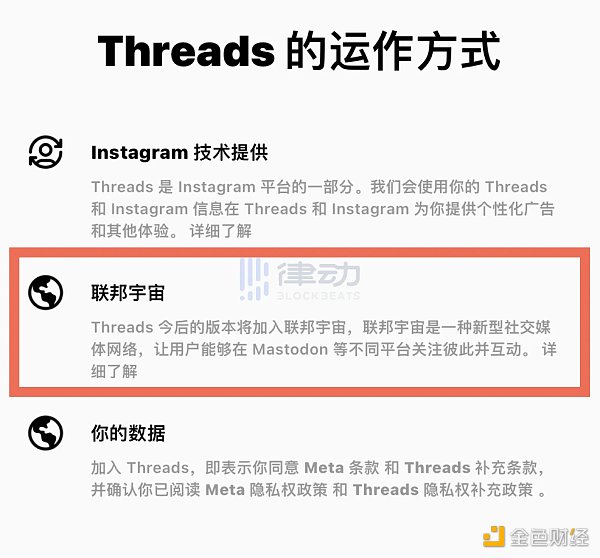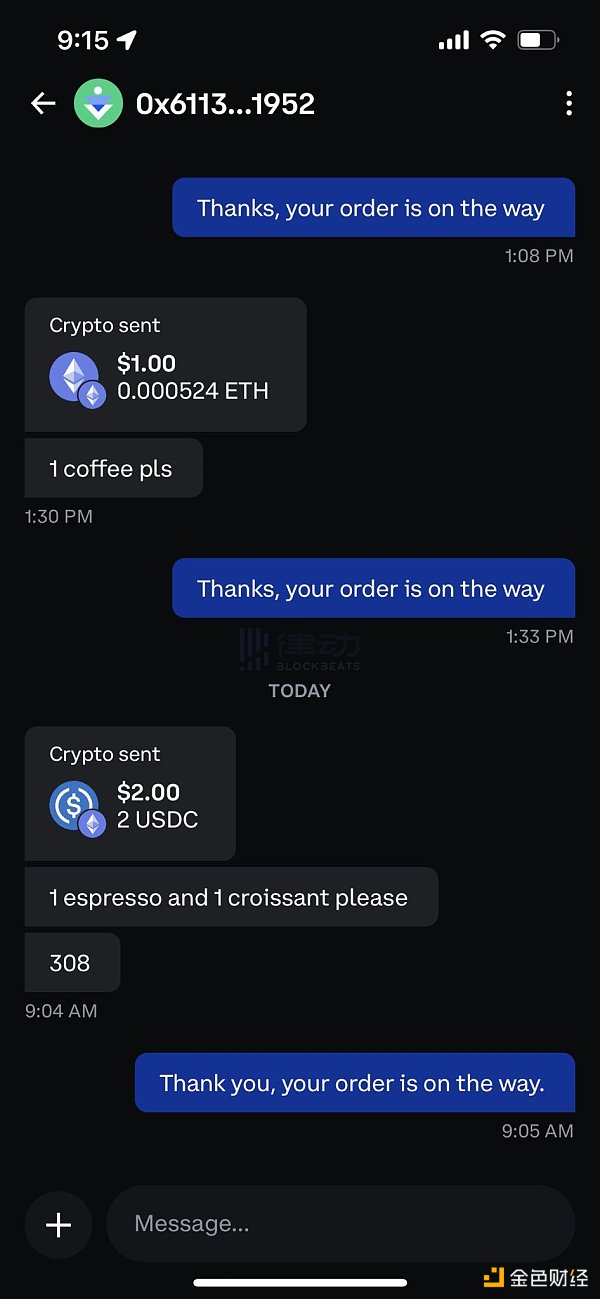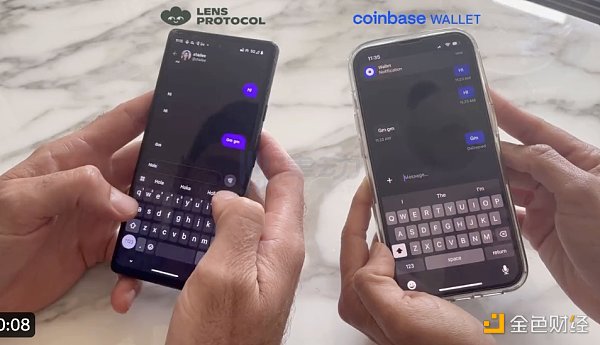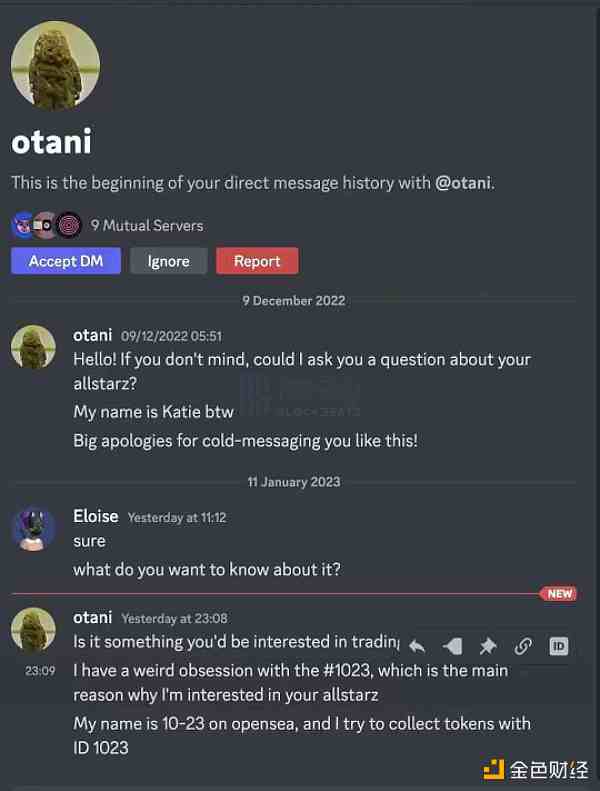Exploring the Decentralized Business Potential of XMTP from the Perspective of Coinbase Wallet’s New Features
Decentralized Business Potential of XMTP in Coinbase Wallet's New FeaturesAuthor: LeftOfCenter, BlockBeats
Developing a high-quality Web3 product is not difficult, but what is difficult is creating a sustainable Web3 business model. When it comes to Web3 business models, it is not just about replicating the user growth and customer acquisition paths of traditional internet, but requires a change in mindset, adopting a new business paradigm brought about by the underlying infrastructure revolution. Only in this way can a strong moat be built, occupying a favorable position when facing the huge internet giants.
This article starts with the built-in chat function of Coinbase Wallet, and analyzes the commercial potential of the Web3 communication protocol XMTP that supports it. The fundamental support for this decentralized business possibility is the “Web3 native experience” that only Web3 products can provide and that corresponding internet products cannot provide. For XMTP users, the most intuitive “encryption native experience” is “real-time cross-application chat with friends,” which is equivalent to connecting WeChat and Alipay accounts for chatting/payment. This magical function is supported by the XMTP underlying protocol and integrated into the Coinbase Wallet application for users.
Because it targets developer users, XMTP as a protocol layer currently does not have a large number of customers. However, in terms of absolute numbers, the adoption of XMTP is still good. Taking the above case as an example, after integrating XMTP, Coinbase Wallet users directly become XMTP users. Unlike consumer users, the protocol layer relies on attracting developers to achieve large-scale user conversion. A large-scale integration can often gain thousands of new users. However, end consumer users cannot directly perceive the existence of the XMTP underlying protocol.
- World Coin Hard to Talk About Fairness?
- Must-read in the evening | Understanding the ‘World Coin’ by OpenAI Founder in One Article
- Opinion Stack’s ability for generalized decentralization is worth paying more attention to, while the narrow decentralization between components such as L2 internal Sequencer and Verifier is more important.
Finally, as more market adoptions of XMTP occur and network effects are formed, consumer users will gradually realize the tangible benefits brought by Web3. The decoupling of functions caused by the Web3 underlying architecture will reduce the importance of front-end services. They will only compete with each other to provide high-quality user experiences. The resulting change is that in the future, application markets like Opensea or Blur will become less important.
Web3 and the Open Internet
In the Threads user interface newly launched by Meta, the parent company of Facebook, there is a piece of copy that says, “Future versions will join a federated universe of a new type of social media network, allowing users to follow and interact with each other on different platforms such as Mastodon.”

Simply put, a federated universe refers to an interconnected server network used for network publishing and file hosting. These servers communicate with each other using an open standard. The most famous service in the Fediverse is Mastodon, which is a social network and communication system similar to Twitter. It implements communication based on a standardized protocol called ActivityPub, allowing anyone who joins this federated universe to communicate with each other. If Threads joins the Fediverse, it means that Threads may be connected to many services based on the ActivityPub protocol, such as Mastodon, to achieve cross-server tracking, mentions, searches, and so on.
This is a place worth noting but easily overlooked by everyone, it means that web2 Internet giants like Facebook are also beginning to embrace open networks.
If you don’t understand its significance yet, you can simply understand that in the future, users can achieve cross-application interaction between Threads and Mastodon, just like WeChat users and Alipay users can achieve cross-application chatting. For Internet mobile users who are accustomed to walled gardens, it can be said to be a magical existence. However, in the early days of the Internet, openness and interoperability were a natural way of working between applications.
In fact, compared to web2, web3, which originated from blockchain technology, has less historical burden of the Internet, and has modular architecture technology stack and programmable financial infrastructure, which gives it inherent advantages in building an open Internet ecosystem and subsequent monetization.
Just as web2 companies like Facebook are actively embracing the open Internet, web3 teams are also not idle, and Coinbase’s wallet is a noteworthy example.
Coinbase Wallet adds communication function
Recently, the cryptocurrency exchange Coinbase announced that its wallet Coinbase Wallet has introduced encrypted communication function.
So far, in addition to asset trading, the official wallet of the second largest exchange in the world will also support wallet internal conversation chat, and all conversations are end-to-end encrypted and privacy-friendly. Apart from having the private key, there is no other way to access this information, truly achieving the same level of security protection as “your private key, your conversation” with encrypted assets.
Interestingly, the new wallet’s built-in chat function is not limited to the Coinbase Wallet application, and can even achieve real-time chat with applications outside of Coinbase Wallet, such as Lensterxyz, orb, or Converse, and even directly search for Lens handle in the Coinbase wallet, and then send messages and encrypted assets to the other party.

Pay for coffee using the wallet and communicate with the seller
By integrating chat conversation function into the encrypted wallet, Coinbase Wallet is trying to provide a holistic experience for cryptocurrency users. Before this, due to the lack of native chat tools, cryptocurrency users usually use multiple different communication chat applications and communities for fragmented communication, from Twitter, Discord, Telegram, Signal to WhatsApp, etc. By combining chat and transactions into one, Coinbase Wallet will provide a unified platform for cryptocurrency users to connect with others and communities.
XMTP: Web3 communication protocol and network
Both the end-to-end security and privacy features of Coinbase Wallet and the implementation of cross-application conversations point to an underlying protocol called XMTP.
According to the official website, XMTP is a universal Web3 communication protocol and network that supports end-to-end encrypted communication between on-chain addresses. Developers can integrate XMTP SDK into dApps without permission to achieve in-app DM and notification functions.
In the XMTP protocol, the message inbox (DM) is bound to the user’s Ethereum address. This means that users can send and receive their notifications through multiple different frontend applications, carry them with them (so-called portable), and migrate all interaction data (including following, posting content, and DM) to other applications at any time, provided that these applications also integrate the XMTP protocol. For example, the real-time chat scene between Lens Protocol users and Coinbase Wallet mentioned earlier is implemented by the XMTP protocol.

The official website showcases the real-time interactive chat between Lens users and Coinbase Wallet.
As long as the application integrates XMTP, they can communicate with each other. As a protocol layer, it connects users from different applications (even different blockchains) to provide them with a seamless conversation experience, even if they are in different applications. In other words, XMTP provides protocol-level message transmission, which is completely unrelated to which frontend it belongs to.
Web3 needs encrypted native communication tools
For a long time, encrypted users have lacked a unified communication platform. Encrypted users and Web3 players usually circulate among multiple different communication chat applications and community channels to view messages and notifications. From Twitter, Discord, Telegram, Signal to WhatsApp, these internet platform tools not only rely heavily on centralized services (which is ironic for Web3, which claims to be decentralized), but also scatter users across multiple different channels, resulting in a fragmented experience. It is easy to miss important messages and notifications and often requires constant switching to keep up with the pace.
Web3 needs encrypted native communication tools, and XMTP is the new infrastructure that builds this encrypted native communication service, mainly solving the communication problem at the underlying layer of Web3.
History tells us that every paradigm shift will produce new infrastructure, fundamentally speaking, it is a change in the new identity system.
In the era of traditional communication, Short Message Service (SMS) was built based on phone numbers. With the rise of Web2, the identity system gradually evolved into social accounts on platforms such as Facebook and Instagram. Fast forward to today, Web3 provides a new identity system-wallet addresses. This means that encrypted native applications need to be built around on-chain addresses.
As a new underlying layer of Web3 communication, XMTP is built around wallet addresses, and all user interactions (such as following, posting, and DM) are tied to specific user addresses.
Based on wallet addresses, a series of encrypted native user scenarios can be derived:
1) Chat between users is wallet-to-wallet, and users’ chats are no longer limited to within one application but can be real-time chats across applications and even across chains;
2) Receiving notifications is also very flexible. Since messages are directly bound to wallets rather than specific clients, theoretically, they can be accessed through different applications built with XMTP. Users can directly obtain community notifications posted through any relevant application by using their wallet addresses, without having to check them one by one on tools like Discord.
When the NFT market integrates protocols like XMTP, the secondary market will become less important. A typical user scenario based on this is when a user sees a desired NFT on the secondary market, they can make an offer to the owner through that market. The user may view relevant messages through related applications (such as Coinbase Wallet or any other XMTP-compatible application), and the buyer and seller can complete the transaction based on a mutually satisfactory price.
The implementation of this scenario is not related to the frontend. When the user receives a notification, it becomes uncertain how the subsequent transaction will be conducted and where it will take place. This is an important transition in decentralized business models.
For NFT collectors and communities, conversations generated around NFTs clearly have special significance. Owners of the same NFT or POAP can send messages to each other to establish connections, and online communities can be formed based on specific NFTs and VIBE, creating social needs.

The author of this article has received special collection requests from users in a certain community, which must have been quite difficult to find the author.
Such conversations and communications, especially for NFT series with community attributes, have special significance. For members, it is much more convenient to communicate wallet-to-wallet via DMs than to trace/search for NFT owners through other tools.
When such scenarios are adopted by the market and the network effect becomes prominent, both secondary markets like Opensea and Blur will become less important. This is where the transition of decentralized business models truly occurs, the true magic of Web3.
The Road to Web3 Decentralized Business
When we talk about Web2 and Web3, a core difference is the difference in their underlying architecture.
Web2 is the era of platforms, where code, databases hosting user profiles, and user communication information are all hosted under the same entity. The underlying architecture of Web3 is completely different, with all these functionalities decoupled and supported by different protocols.
The changes in underlying technology and the difference in architecture inevitably bring about the evolution of Web3 business logic.
Web2 platforms provide great convenience to Internet users in terms of experience with their “all-in-one” model, but at the same time, they control user data and have supreme power. In this situation, the platform is the winner and monopolies in the Internet platform cannot be challenged.
In contrast, Web3 users deeply integrated with wallets can freely migrate from one application to another. When the migration cost is so low, Web3 users are dispersed across various applications and compared to Web2 platforms, they exhibit a fragmented characteristic. We believe that in the short term, most Web3 consumer applications cannot compete with social media giants in terms of user base, which will be much smaller.
This is also why products like Status have never been truly adopted and eventually failed to succeed.
In fact, as early as 2017, Status launched a wallet-based communication application, which was smooth and considered a good wallet communication application. It is basically a blockchain version of WeChat, providing chat, wallet payments, and a companion web3 mobile browser. In addition, the team has sufficient funding support, raising over $100 million in ICO in 2018.
Although Status and XMTP have similar overall functions, Status does not provide an interoperable inbox. In other words, Status essentially follows the same transformation path as traditional Internet, targeting consumer users and aiming to convert consumer users.
Unlike targeting consumer users, the protocol layer relies on attracting developers to achieve large-scale user conversion. A single large integration can often attract thousands of new users. For XMTP, as a neutral protocol layer, it provides unified, standardized, end-to-end encrypted communication functions for applications. This is a real demand, as long as the developer experience is good enough, theoretically it will attract more application developers to develop applications on it, continuously attracting developers to develop applications on top of it and accelerating expansion.
For communication protocols like XMTP, the key to attracting developers lies in enhancing the product’s competitive advantages, including: 1) providing intuitive and seamless web3 integration experience that is not only cheap but also high-performance, in order to meet existing communication standards; 2) providing interoperability to ensure cross-platform compatibility and communication; 3) scalability and privacy to ensure efficient, encrypted communication and data protection, to protect user privacy and sovereignty; 4) providing powerful tools to facilitate integration and third-party development, enhancing the developer experience.
Currently, XMTP only supports DM and notification functions for Ethereum and EVM-compatible blockchains. In the future, it will provide more functions such as replies, reactions, and payments. At the same time, it will no longer be limited to EVM compatibility and will support cross-chain communication. It may even support communication for applications outside the blockchain, including Discord and Mailchimp. This means that it can not only aggregate existing Web3 users but also potentially bring incremental users to the encryption industry and expand new users on the Internet.
In terms of data, there are not many developer users of XMTP, but in absolute numbers, the adoption of XMTP is still good. So far, the integration of Lens alone has brought 116,000 personal accounts to XMTP. Since its launch in early 2022, XMTP has generated nearly 1 million XMTP inboxes on the network and sent over 300,000 DMs. Once Lens is fully open for registration, this number will increase sharply. The integration with Coinbase Wallet will also bring in a large number of early seed users.
With the integration of more projects, the user base of XMTP will grow exponentially. Once cumulative network effects are achieved, it will occupy a market advantage that competitors find difficult to shake. It can be said that in Web3, the competition for users lies in the underlying protocols, while frontend services are responsible for providing high-quality user experiences.
Conclusion
It is worth noting that Coinbase Ventures, the capital behind Coinbase Wallet, participated in XMTP’s Series A $20 million financing completed in August 2021. This also explains why the relatively unknown XMTP is strongly associated with mainstream wallets like Coinbase Wallet. By integrating XMTP, Coinbase Wallet has added encrypted communication functionality for wallet users and also provided the initial batch of seed users required for XMTP protocol’s cold start.
Native crypto users are currently the scarcest resource in the industry, and acquiring them is also the most difficult task for Web3 projects. As the official wallet of Coinbase, one of the world’s top exchanges, Coinbase Wallet has over 100 million crypto users from more than 100 countries/regions. The integration of XMTP will enable the wallet’s seed users to promote more developer cooperation resources for XMTP expansion. After all, as long as they join XMTP, they can share this group of early users, which is very attractive to other protocols or application developers. Joining the XMTP ecosystem to share users will also become a “must” choice for developers.
Coinbase Wallet is available in over 100 countries/regions and is one of the largest crypto wallets. Considering that its parent company Coinbase is the second largest cryptocurrency exchange in the world, it makes sense for users of this exchange to use its wallet. It’s similar to how I use Google products for email, browsing, and so on. Sometimes you just stick with the brands and companies you know.
We will continue to update Blocking; if you have any questions or suggestions, please contact us!
Was this article helpful?
93 out of 132 found this helpful
Related articles
- Worldcoin The Dystopian Nightmare of Cryptocurrency
- The Game of Trust Rollups Controlled by Multisig and Committees
- DID Identity System General Knowledge (Part 1)
- Rollup as a Service Economic Mechanism Analysis How can service providers increase profits?
- Interpreting Unibot related data
- Summary of the 9 key points of Ethcc consortium chains, beware of the assumption of honest majority, integration of Cosmos and Ethereum ecosystems…
- Encrypted VC Why We Invest in Unibot






